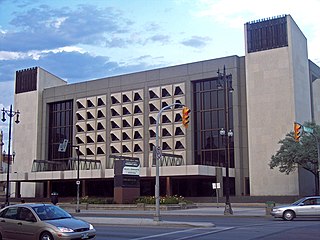This article needs additional citations for verification .(July 2013) |
Uganda National Contemporary Ballet or UNCB is a Ugandan dance company established in 2007 as Burudani Dance Company.
This article needs additional citations for verification .(July 2013) |
Uganda National Contemporary Ballet or UNCB is a Ugandan dance company established in 2007 as Burudani Dance Company.
On September 16, 2007, with the backing of Alliance Française and the UGCS/Goethe Institute, Black & White and Memories of Child Soldiers were presented for the first time at the Ndere Centre in Kampala. [1] The performances, involving 15 professional Ugandan dancers and choreographed by Valerie Miquel, was so popular that the group went on to form the Burudani Dance Company that is being head by Valerie Miquel as the Company Director.
This section needs to be updated.(March 2023) |
In November 2007, the company was featured in a broadcast to a well known French-German TV programme Arte Metropolis. In February 2008 UNCB performed for the President of Germany and his delegation, as well as for representatives of the government of Uganda under Burudani Dance Company. UNCB has toured France in May 2008, Germany in September to October 2008, and East Africa in October 2008. Since March 2009, Burudani Dance Company changed its name to the Uganda National Contemporary Ballet (UNCB). UNCB performs a minimum of two shows a month at the National Theatre in Kampala and several shows at corporate functions at Serena hotel, Sheraton Hotel, Hotel Africana plus many such venues like Munyoyo etc.
UNCB has also created pieces for the following : Goethe Centre, Alliance Française, Europe Uganda Village, Orange, International Women Organization, Goethe Centrum, the Global 2009 Smart Partnership Dialogue, Rotary Club, Thermal Cool Uganda, Ugandan Wildlife Authority to help celebrate the International Year of the Gorilla, Japanese Embassy, Fang Fang Restaurant (Chinese New Year), Norwegian Embassy, as part of an international workshop for women’s rights, for the prevention of domestic violence in Uganda.

The Goethe-Institut is a non-profit German cultural association operational worldwide with 159 institutes, promoting the study of the German language abroad and encouraging international cultural exchange and relations. Around 246,000 people take part in these German courses per year.
The National Ballet of Canada is a Canadian ballet company that was founded in 1951 in Toronto, Ontario, with Celia Franca, the first artistic director. A company of 70 dancers with its own orchestra, the National Ballet has been led since 2022 by artistic director Hope Muir. Renowned for its diverse repertoire, the company performs traditional full-length classics, embraces contemporary work and encourages the creation of new ballets, as well as the development of Canadian dancers and choreographers.

The Royal Winnipeg Ballet is Canada's oldest ballet company and the longest continuously operating ballet company in North America.
Kololo is a hill in Kampala, the largest city and capital of Uganda. The name also applies to the upscale residential and commercial neighbourhood that sits on that hill.

Queensland Ballet, founded in 1960 by Charles Lisner, is the premier ballet company of Queensland, Australia, and is based in Brisbane. It is one of only three full-time, professional classical ballet companies in Australia. The company has had six previous Artistic Directors, and is currently led by Greg Horsman.

The New National Theatre, Tokyo (NNTT) is Japan's first and foremost national centre for the performing arts, including opera, ballet, contemporary dance and drama. It is located in the Shinjuku area of Tokyo. Since 1997 more than 650 productions were staged. There are about 300 performances per season with approximately 200,000 theatergoers. The centre has been praised for its architecture and state-of-the-art modern theatre facilities, which are considered among the best in the world. In 2007, the NNTT was branded with the advertising slogan: Opera Palace, Tokyo.
Ballet Philippines (BP) is a ballet company in the Philippines founded in 1969 by Alice Reyes with the support of Eddie Elejar and the Cultural Center of the Philippines. Proficient in both ballet and modern dance, the company synthesizes diverse dance and movement forms into distinctively Filipino contemporary expressions. These include classical ballet, avant-garde choreography, traditional and modern dance, martial arts, and aerial movements.
Ceremonial dancing has a very important place in the Indigenous cultures of Australia. They vary from place to place, but most ceremonies combine dance, song, rituals and often elaborate body decorations and costumes. The different body paintings indicate the type of ceremony being performed. They play an important role in marriage ceremonies, in the education of Indigenous children, as well as storytelling and oral history. The term corroboree is commonly used to refer to Australian Aboriginal dances, although this term has its origins among the people of the Sydney region. In some places, Aboriginal people perform corroborees for tourists. In the latter part of the 20th century the influence of Indigenous Australian dance traditions has been seen with the development of concert dance, with the Aboriginal Centre for the Performing Arts (ACPA) providing training in contemporary dance.

Dame Margaret van Praagh was a British ballet dancer, choreographer, teacher, repetiteur, producer, advocate and director, who spent much of her later career in Australia.
James Kudelka, OC, is a Canadian choreographer, dancer, and director. He was the artistic director of the National Ballet of Canada from 1996 to 2005, now serving as the National Ballet's artist in residence.
Sabrina Matthews is a Canadian ballet choreographer. She has created pieces for some of the most prestigious ballet companies in the world, including multiple pieces for the renowned Stuttgart Ballet. This in-demand choreographer has premiered works on three continents in over a dozen cities from Beijing, to New York, to London. She was recognized as one of Canada's Amazing Women to Watch, alongside Oscar nominees. Sabrina Matthews has received commissions from Stuttgart Ballet, Royal Swedish Ballet, Boston Ballet, England's Royal Academy of Dance's Genee International Ballet Competition, and the National Ballet of Canada. Her works have been performed by major international ballet companies in Canada, the United States, Spain, Sweden, Germany, Italy and the Netherlands.
The Dayton Ballet is a ballet company based in Dayton, Ohio.

Nakasero is a hill and neighborhood in the centre of Kampala, the capital and largest city of Uganda. Nakasero is important to Uganda's economy and politics, as it is home to Kampala's central business district and several government offices, including the Ugandan Parliament Buildings.
Michael Tsegaye is an Ethiopian artist and photographer. Much of his work presents a glimpse of life in contemporary Ethiopia, although an extended catalogue of his images come from his travels abroad.

Kabalagala is a neighbourhood in Kampala, the capital and largest city in Uganda. It houses some of the leading partygoers in the city. It is located next to Nsambya where the American Embassy in Uganda is found.
The following is a timeline of the history of the city of Kampala, Buganda, Uganda.
Kabubi Herman is a Ugandan author and poet. He uses the stage name "Slim Emcee ". He is poetry teacher, as well as a performance poet. He took part in the spoken word project Kampala Uganda, in 2013.

Esteri Tebandeke is a Ugandan filmmaker, actress, dancer and visual artist. She is a graduate of the Margaret Trowell School of Industrial and Fine Art at Makerere University.
Odeke Peter Paul is a Ugandan film, voice and theatre actor, radio presenter and voice artist. He first appeared on a national stage in the early 1990s with “SPECTRUM”, a contemporary dance-drama group that followed in the infamous style of the Namasagali College’s productions.

German-Uganda relations have existed since 1962 and are described by the German Foreign Office as "positive". Uganda is one of the priority countries of German development aid and more than 100 associations and initiatives from Germany support humanitarian projects in Uganda.